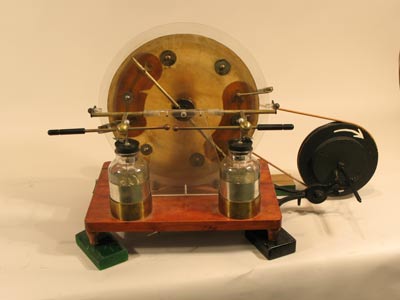|
Size: 2067
Comment:
|
← Revision 7 as of 2013-07-12 18:18:15 ⇥
Size: 2139
Comment: converted to 1.6 markup
|
| Deletions are marked like this. | Additions are marked like this. |
| Line 1: | Line 1: |
| #acl reardon:read,write,delete,revert,admin FacultyGroup:read,write All:read | |
| Line 3: | Line 4: |
| The big Toepler-Holtz Machine which is used in many demonstrations is located in the [:ElectrostaticsCabinet:Electrostatics Cabinet], A3. There are two other smaller Toepler-Holtz Machines located in the [:ElectrostaticsCabinet:Electrostatics Cabinet], A4, but as of 4/2008 they are both in need of repair. |
{{attachment:ToeplerHoltz5A5015.jpg}} The big Toepler-Holtz Machine which is used in many demonstrations is located in the [[ElectrostaticsCabinet|Electrostatics Cabinet]], A3. There are two other smaller Toepler-Holtz Machines located in the [[ElectrostaticsCabinet|Electrostatics Cabinet]], A4, but as of 4/2008 they are both in need of repair. |
| Line 14: | Line 17: |
| The Toepler-Holtz works by amplifying initially small potential differences between the electrodes through a process of positive feedback, much like the [:WimshurstMachine:Wimsurst Machine]. | When finished, discharge the machine: use the insulated handles to bring the electrodes together again. Notes: The spark from the big Toepler-Holtz Machine carries higher current than the Department's Wimshurst machine or Van de Graaff Generator, possibly a large enough current to cause injury. Discharge the machine before touching the metal parts, or allowing students near it. The Toepler-Holtz works by amplifying initially small potential differences between the electrodes through a process of positive feedback, much like the [[WimshurstMachine|Wimsurst Machine]]. |
| Line 25: | Line 35: |
| When finished, discharge the machine: use the insulated handles to bring the electrodes together again. | |
| Line 27: | Line 36: |
| The spark from the big Toepler-Holtz Machine carries higher current than the Department's Wimshurst machine or Van de Graaff Generator, possibly a large enough current to cause injury. Discharge the machine before touching the metal parts, or allowing students near it. | [[Electrostatics]] |
| Line 29: | Line 38: |
| attachment:ToeplerHoltz5A5015.jpg | [[Demonstrations]] |
| Line 31: | Line 40: |
| [:Electrostatics:Electrostatics] [:Demonstrations:Demonstrations] [:Instructional:Home] |
[[Instructional|Home]] |
Toepler-Holtz Machine 5A50.15

The big Toepler-Holtz Machine which is used in many demonstrations is located in the Electrostatics Cabinet, A3. There are two other smaller Toepler-Holtz Machines located in the Electrostatics Cabinet, A4, but as of 4/2008 they are both in need of repair.
Use the insulated handles to bring the electrodes together before attaching any leads to the Toepler-Holtz.
Make sure all five points of support of the Toepler-Holtz are on a solid surface (ie there is a fifth point of support beneath the crank).
When ready to use, separate the electrodes by several cm.
Turn the crank in the direction of the arrow. Sparks should jump between the electrodes.
When finished, discharge the machine: use the insulated handles to bring the electrodes together again.
Notes:
The spark from the big Toepler-Holtz Machine carries higher current than the Department's Wimshurst machine or Van de Graaff Generator, possibly a large enough current to cause injury. Discharge the machine before touching the metal parts, or allowing students near it.
The Toepler-Holtz works by amplifying initially small potential differences between the electrodes through a process of positive feedback, much like the Wimsurst Machine.
On our Toepler-Holtz machine, the right-hand terminal always charges positive, the left-hand terminal negative.
If you turn the crank the right way, the spark may jump as much as 5 cm, implying a potential on the order of 100kV. If you turn the crank the wrong way, the maximum distance the spark will jump is about 500 microns.
There is a lever in the front bottom center of the machine:
- lever in left-hand position for high voltage, low current (capacitors connected to each other);
- lever in center position for high current, low voltage (capacitors disconnected from each other).